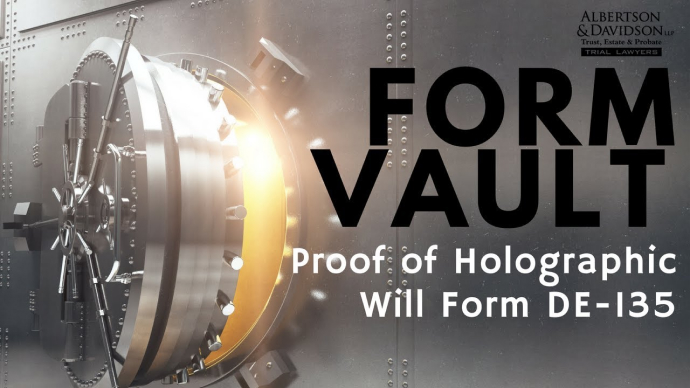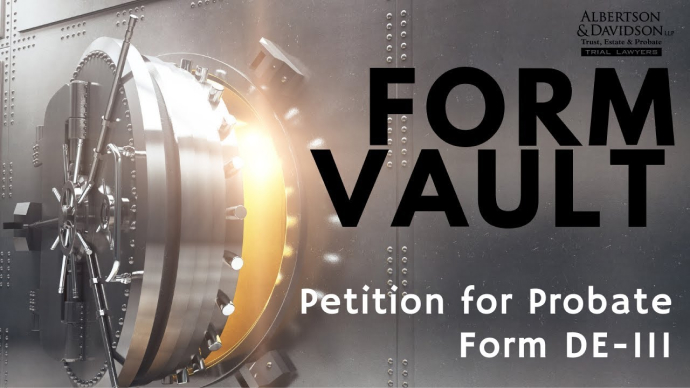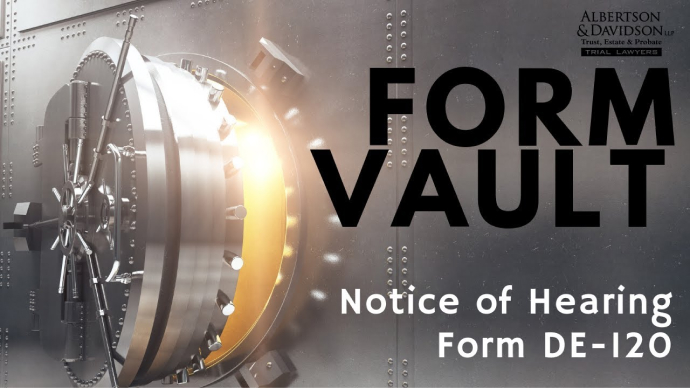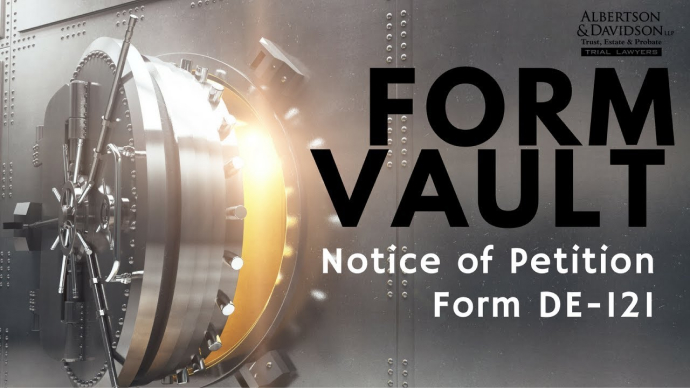Video Transcript
The following is an unedited, verbatim transcript of our video. It is not intended to be a stand-alone article.
Hi, this is Keith Davidson of Albertson & Davidson. In this video we’re going over form DE – 135 which is a proof of holographic instrument. Before we get started let us talk about what holographic instrument even is. A holographic will is a will that is written in the own handwriting of the testator. So the person creating the will simply wrote it out on something, a piece of paper, back of an envelope, napkin, post-it note and then they sign it. And holographic wills don’t need witnesses so you don’t have to have two witnesses like you do with every other type of will. It only has to be written in the testator’s handwriting and that’s it. And that’s what makes us comfortable that it really is the testator’s intent because they wrote it out themselves. And that’s what a proof of holographic instrument is. And so if you have a handwritten will when you file your petition for probate, to admit that Will to probate, first of all you going to have to submit a typewritten version of it. So you actually have to transcribe the handwriting into a typed document and you have to submit both those to the court. But you also need somebody to be able to say that, I know the testator’s handwriting and I can state under penalty of perjury under oath that that this is in fact their handwriting and for that reason it should be recognized as a valid holographic will.
So let’s go to the form and we’ll see how this works. We’re going to start as always at google, type in, judicial council, and we’re going to go right to the court’s website where we can find all the forms that we need for probate. They’re all free, they’re all fillable PDF, you don’t have to pay a penny to do this. It is really fantastic. Now I happen to know that we are looking for form DE – 135 if I didn’t know that, you obviously could just go up here and search by name, search by number – the form number. So let’s go to DE – 135. I pre-filled in my information up top so we didn’t have to waste time on that but let’s see how this form works. So we’re back to being the attorney for Bob Smith and we’re going to do the estate of Rachel Smith. Now if you don’t have the case number yet, you can leave that blank. You should, if you have a holographic will, a handwritten will, you should know that you need this form before you file your petition for probate. So just fill this out and have it ready to go when you go down the court house and file your petition for probate. Lot of times people don’t that they need this form. So they’ll file the petition and then they’ll get a note from the court coz the court puts out probate note before your initial hearing and in that note it’ll say “proof of holographic instrument required.” Okay, then you’ll already have the case number at least so put that in there.
So number 1, I was acquainted with the decedent for the following number of years. So let’s say Bob’s filling this out and you know he was married to Rachel for 30 years. So we need to know that this is somebody who has some experience witnessing the decedent’s handwriting. I was related to the decedent as, so in this case it’s going to be spouse but it could be friend, it could be cousin, it could be brother, it could be son, daughter, whatever it is, parent. I have personal knowledge of the decedent’s handwriting which I acquired as follows, so the whole point of this form is to have somebody, a witness, who can testify, that’s what this form is, it’ testimony under oath, just have to be in written form but it’s testimony under oath that I know the decedent’s handwriting and I can swear under oath that this holographic document is the decedent’s handwriting. So the form wants to know, that law wants to know, how do you know that it’s the decedent’s handwriting? How did you acquire this knowledge of their handwriting? Well either I saw the decedent write. So you know as a spouse you’re going to see your spouse write thing down from time to time throughout your relationship, so I saw it, I’m familiar with it, I saw my spouse write things down all the time. I know what her handwriting looks like or his handwriting looks like, or I saw a writing purporting to be in the decedent’s handwriting and upon which decedent acted or was charged. So in other words, there is some document that I saw and then I can compare that to the current document. So I may not have seen them write personally but I saw something that was in their writing and it was something that the person who did the handwriting acted on and so that gives us confidence that it was in fact their handwriting. Most of the time it’s going to be A, when you’re usually filling this out, you want somebody to fill this out who has seen the hand writing. It just makes it a lot more solid and a lot more believable and truthful. Under C, so this is the next option. So if you don’t mean A or B, C is I received letters in the due course of mail purporting to be from the decedent in response to letters I addressed and mailed to the decedent. So I’m not sure that anybody does this anymore, I’m sure there are people who still send letters through the mail, it’s such, I mean obviously that doesn’t happen a lot anymore. But if you did, if you send somebody a letter and they responded to you by handwritten letter and that’s how you knew it’s their handwriting then you would select C. It’ll be interesting to know how often C is checked when people fill out this form with the court. I’d have to think it’s pretty rare. And D would just be other means. So other means of obtaining knowledge. If it doesn’t fit in to A, B or C you need to select A. You need to find somebody that fits in the A though. I mean it doesn’t have to be. Even though Bob Smith’s the one who’s bring this probate, let’s say he never saw the handwriting but Rachel’s daughter did, well then I would have Rachel’s daughter fill this out and sign it. Because anybody who has personal knowledge and has seen the writing it’s going to be the best witness.
Number 4, I have examined that attached copy of the instrument, which is the hand written will, and its handwritten provisions were written by and the instrument was signed by the hand of the decedent. So number 4 is really the important part coz what you’re saying is I’m a person who knows knowledge of the handwriting of the decedent, I saw the decedent write in the past that’s how I acquired that knowledge. And number 4, I looked at this holographic will and by looking at it and based on my experience of the decedent’s handwriting, I can say under penalty of perjury that this in fact is the decedent’s handwriting. And this is signed under declaration under penalty of perjury so obviously the person signing it has to actually look at the will. Otherwise, they are lying and that’s not good. So make sure that whoever signing this has looked at the will and you just ask them, does that look like the decedent’s handwriting. And if they say yes then sign right here. And then they’ll date it, you’ll type in their name and they’ll sign it.
Then here we have an attorney’s certification. This is just so that the attorney can certify under penalty of perjury that the attached copy of the holographic will is a true and correct copy of the document that it’s supposed to be. So in other words you don’t want to show a witness one document and then file some other document as the holographic will. You want to make sure that the witness is looking at the same document. So when you get to the end you can print this form, you can save it and then you will take it down to the court and file it. And when you file it you will then have your proof of holographic instrument. You only need this if you’re dealing with a handwritten will but you don’t need it if it’s a typewritten will. So it’s going to be a relatively rare form to use but when you need it now you know a little bit something about it. And this is our video on Form DE – 135, proof of holographic instrument.




